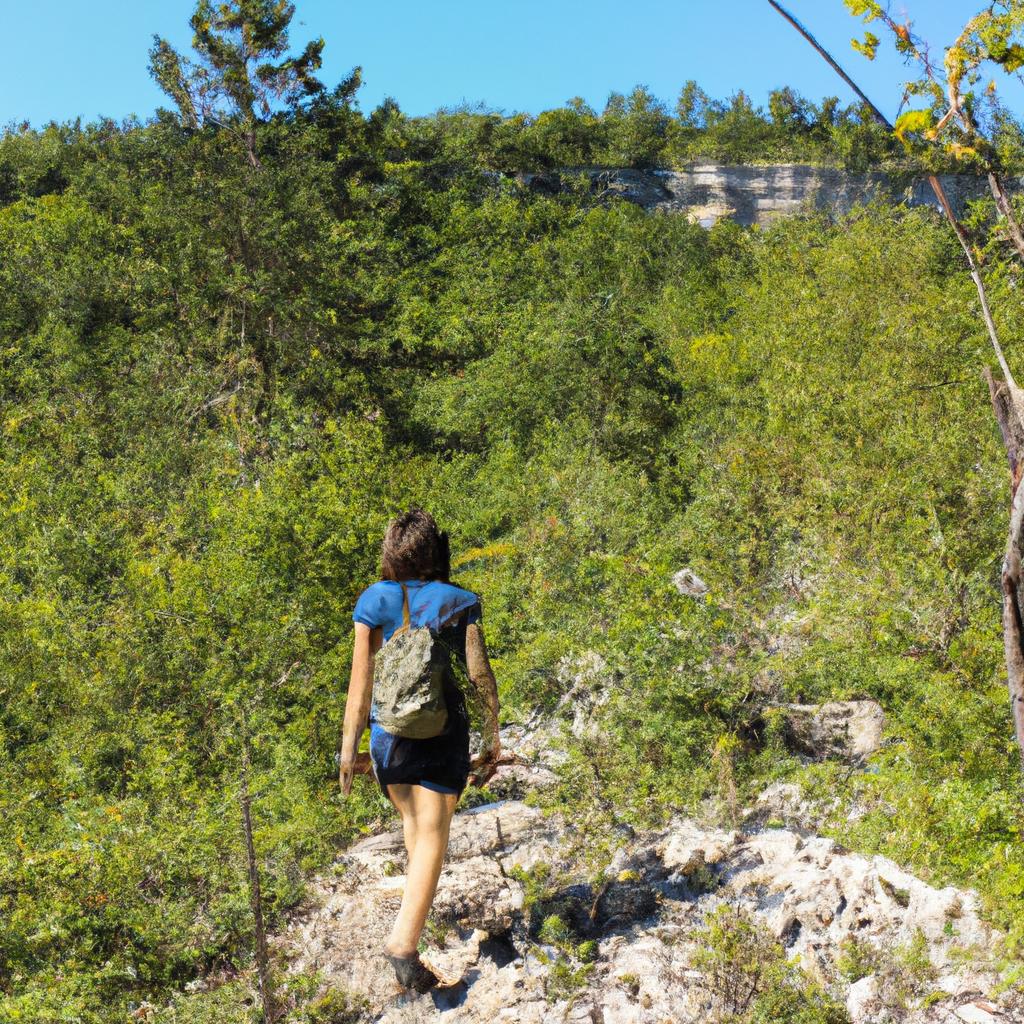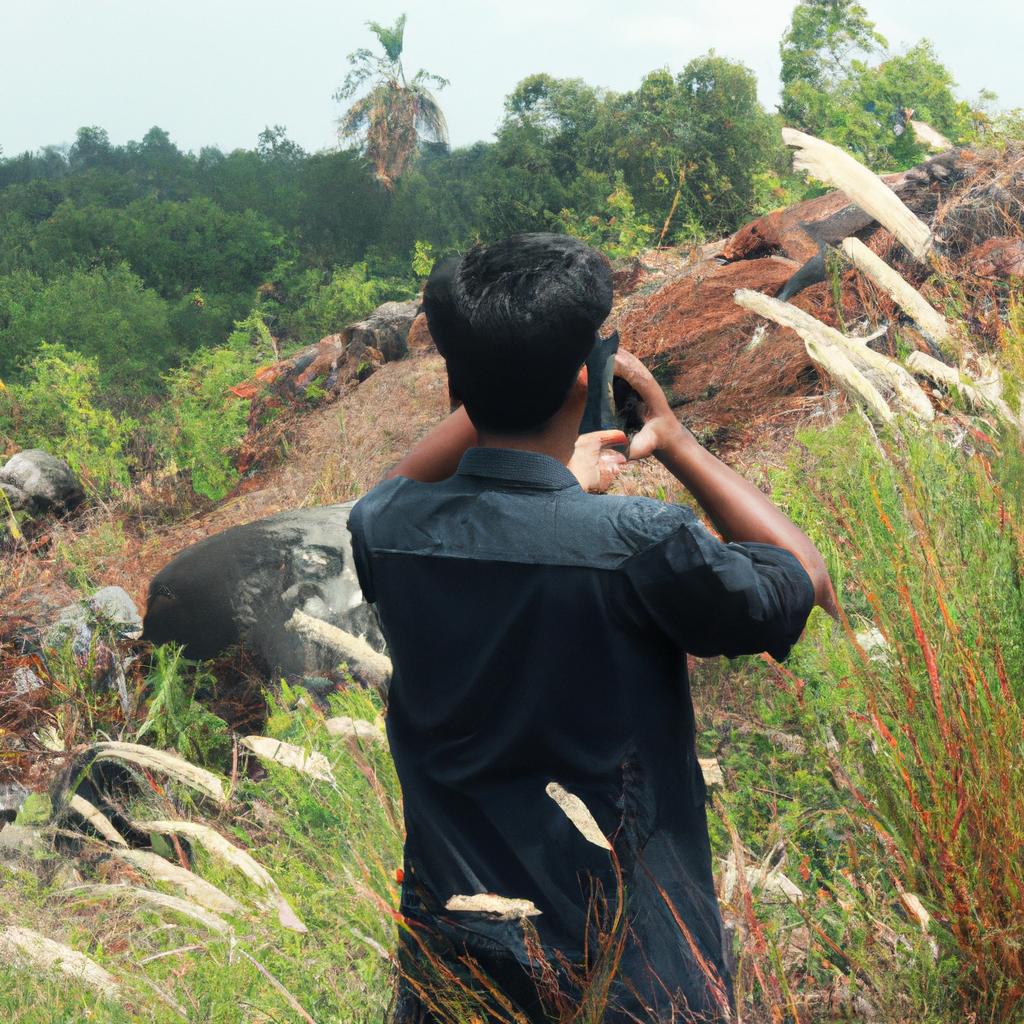Outdoor survival skills are crucial for individuals engaging in travel recreation activities, ensuring their safety and well-being amidst unpredictable outdoor environments. These essential skills equip adventurers with the knowledge and abilities needed to navigate challenging terrains, secure shelter and sustenance, as well as handle emergencies that may arise during their expeditions. For instance, consider a hypothetical scenario where a group of hikers becomes stranded in a remote mountainous region due to unforeseen weather conditions. In such circumstances, possessing adequate outdoor survival skills can be the difference between life and death.
In recent years, there has been an increase in the popularity of adventure funding in travel recreation, prompting a growing interest in acquiring necessary survival skills among enthusiasts. As more individuals venture into nature’s vast expanse seeking thrilling experiences and personal growth, it is imperative to understand the fundamental principles of surviving outdoors. This article aims to provide essential information on outdoor survival skills that will not only maximize one’s chances of overcoming potential hazards but also enhance the overall experience of embarking on adventurous journeys. By exploring various aspects such as navigation techniques, wilderness first aid, fire building methods, food procurement strategies, and emergency signaling procedures, adventurers can fortify themselves with invaluable knowledge before setting foot into uncharted territories.
Choosing the Right Outdoor Gear
When embarking on an outdoor adventure, one of the most crucial aspects to consider is selecting appropriate gear. The right equipment can significantly enhance your experience and ensure your safety in various conditions. For instance, imagine a hiker who sets out on a challenging mountain trail without proper hiking boots. As they progress, discomfort turns into pain, making every step more arduous than the last. This example underscores the importance of choosing suitable outdoor gear.
To make informed decisions about what gear to invest in, it is essential to understand its purpose and functionality. A well-rounded approach involves considering factors such as durability, weight, comfort, and versatility. Durability ensures that the gear will withstand wear and tear over extended periods of use. Lightweight options prevent excessive strain while carrying them during long treks or hikes. Comfortable products allow you to focus on enjoying your surroundings rather than being distracted by discomfort or irritation caused by ill-fitting gear. Lastly, versatile items provide adaptability for different weather conditions or terrains.
Consider the following bullet points as guidelines when evaluating potential outdoor gear:
- Opt for high-quality materials that are both durable and lightweight.
- Prioritize gear with adjustable features to accommodate individual preferences.
- Look for waterproof or water-resistant properties to protect against unexpected rainfall.
- Choose multi-purpose items that serve multiple functions to minimize bulkiness.
Additionally, refer to the table below which compares three popular brands offering outdoor jackets based on key criteria:
| Brand | Material | Waterproof Rating | Weight (grams) |
|---|---|---|---|
| Brand A | Nylon | High | 500 |
| Brand B | Polyester | Medium | 650 |
| Brand C | Gore-Tex | Very High | 400 |
By employing these assessment tools along with personal considerations regarding budget and style preference, you can make well-informed decisions about the gear that best suits your needs.
In transitioning to understanding basic navigation techniques, it is crucial to have a solid grasp of how various tools and methods can guide you during outdoor excursions.
Understanding Basic Navigation Techniques
As adventurers, we know that choosing the right outdoor gear is crucial for a successful journey. Now, let’s delve into another essential aspect of outdoor survival skills – understanding basic navigation techniques.
Imagine you find yourself deep in the heart of a dense forest during an unplanned solo hike. With no clear markers or signs to guide your way, panic might set in. However, with a solid foundation in basic navigation techniques, you can confidently navigate through unfamiliar terrains and ensure your safe return home.
To assist you on this journey, here are four vital navigation techniques every adventurer should master:
-
Map Reading:
- Use topographic maps to identify key features such as hills, rivers, and valleys.
- Understand map symbols and legends to interpret information accurately.
-
Compass Navigation:
- Learn how to use a compass to determine direction by aligning it with magnetic north.
- Utilize declination adjustments based on your current location for accurate readings.
-
GPS Usage:
- Familiarize yourself with handheld Global Positioning System (GPS) devices or smartphone applications.
- Learn how to mark waypoints and follow routes for easy navigation.
-
Celestial Navigation:
- Master the art of using celestial bodies like stars and the sun for orientation when traditional methods fail.
- Understand concepts such as azimuths and altitude angles for effective celestial navigation.
Now that we have explored these basic navigation techniques, you will be better equipped to tackle various challenges that may arise during your adventures. By being proficient in these skills, you can embark on thrilling journeys knowing that you possess the knowledge needed to navigate through even the most treacherous landscapes.
In our next section about building shelters in different environments, we will explore ways to protect ourselves from unpredictable weather conditions while out in nature’s embrace. So let us continue our exploration without delay!
Building Shelters in Different Environments
Transitioning from our previous discussion on basic navigation techniques, let us now delve into the crucial skill of building shelters in different environments. Imagine you are hiking through a dense forest and suddenly find yourself caught in an unexpected downpour. Without proper shelter, you would be left vulnerable to the elements, risking hypothermia or other severe consequences. Learning how to construct adequate shelters is vital for any outdoor enthusiast.
When it comes to building shelters, understanding your surroundings is essential. The type of shelter you create will depend on various factors such as weather conditions, available resources, and terrain. For instance, in wooded areas where trees are plentiful, constructing a lean-to shelter can provide effective protection against rain and wind. By leveraging sturdy branches and foliage along with natural features like tree trunks or large rocks as support beams, one can quickly assemble a secure structure.
In contrast, when faced with open landscapes lacking vegetation coverage or rocky terrains that make traditional shelters impractical, improvisation becomes key. In these situations, relying on man-made objects or using alternative materials such as tarps or emergency blankets may prove invaluable. Additionally, knowledge of knot tying techniques helps ensure stability and durability when constructing makeshift shelters.
Building shelters not only provides physical protection but also offers psychological comfort during challenging circumstances. Consider the emotional impact of having a safe refuge amidst harsh conditions:
- A sense of security washes over you as you huddle inside your well-built shelter.
- Relief floods your mind knowing that you have shielded yourself from the cold winds and heavy rainfall.
- An overwhelming feeling of accomplishment surges within you upon successfully assembling a shelter that stands strong against nature’s forces.
- A deep gratitude emerges as you realize the importance of being prepared and equipped with survival skills for unforeseen situations.
To summarize, mastering the art of building shelters allows adventurers to adapt to diverse environments while ensuring their safety and well-being. Whether constructing a lean-to in a forested area or improvising with available resources in open landscapes, the ability to create secure havens is crucial for outdoor survival.
Moving forward, let us now shift our focus to another fundamental skill: finding and purifying water sources.
Finding and Purifying Water Sources
Transitioning from the previous section on building shelters, let’s now explore an equally crucial aspect of outdoor survival skills: finding and purifying water sources. Picture this scenario: you’ve been hiking for hours under the scorching sun, feeling your throat parched with every step. Suddenly, you stumble upon a small stream glistening in the distance – a glimmer of hope amidst the arid landscape. Understanding how to identify and make water safe for consumption is imperative in such situations.
To illustrate the importance of this skill, imagine being deep within a dense forest during a backpacking trip when your main water supply runs out unexpectedly. In this hypothetical case, knowing where to find alternative water sources becomes vital for ensuring your hydration needs are met. Let’s delve into three key strategies that will aid you in locating viable water sources:
-
Map Study:
- Familiarize yourself with topographic maps or guidebooks before embarking on any adventurous journey.
- Identify nearby rivers, lakes, or springs as primary potential water sources.
- Be aware of seasonal variations that may affect their reliability.
-
Visual Cues:
- Look for signs of vegetation like lush greenery or clusters of trees which can indicate hidden streams beneath.
- Observe wildlife movements as they often lead towards reliable watering holes.
- Keep an eye out for natural depressions or hollows where rainwater may collect.
-
Natural Indicators:
- Learn to recognize geographical features that suggest accessible groundwater reserves such as valleys, low-lying areas, or even rocky formations.
- Notice damp soil patches or muddy spots along riverbanks which could be indicative of underground springs.
In addition to locating water sources, it is essential to ensure its safety by practicing adequate purification methods. Here is a table outlining four common techniques:
| Method | Description | Pros | Cons |
|---|---|---|---|
| Boiling | Heating water until it reaches a rolling boil. | Kills most microorganisms and pathogens. | Time-consuming and requires fuel or heat source. |
| Chemical | Using tablets or drops to disinfect the water. | Lightweight and effective against many organisms. | Some chemicals may leave an unpleasant taste. |
| Filtration | Passing water through a physical filter medium. | Removes bacteria, protozoa, and larger particles. | May not eliminate viruses; filter maintenance required. |
| UV Sterilization | Exposing water to ultraviolet light | Quick and easy process with no aftertaste. | Requires batteries or charging for portable devices |
By understanding how to find potential water sources in different environments and employing suitable purification methods, you significantly increase your chances of survival during outdoor adventures.
As we continue our exploration of essential outdoor survival skills, let’s now shift our focus towards fire starting methods and campfire safety
Fire Starting Methods and Campfire Safety
Water is a vital resource in any outdoor survival situation, but it’s not the only element necessary for staying safe and comfortable. Another crucial skill to master is fire starting. The ability to start a fire can provide warmth, cook food, purify water, and even signal for help if needed. In this section, we will explore various fire starting methods and discuss important campfire safety practices.
Paragraph 1:
Imagine you find yourself stranded in the wilderness with limited supplies. It’s getting dark, temperatures are dropping rapidly, and you need to create a source of heat quickly. One effective method for starting a fire is using flint and steel or a ferrocerium rod. By striking these two materials together at an angle towards dry tinder, such as birch bark or cotton balls coated in petroleum jelly, sparks are created that can ignite the tinder bundle. This technique requires practice and patience but can be lifesaving when there are no matches or lighters available.
Paragraph 2:
When it comes to campfire safety, following proper precautions is essential to prevent accidents and protect the environment. Here are some key guidelines to keep in mind:
- Select an appropriate location away from overhanging branches, dry grasses, or other potentially flammable objects.
- Clear a designated area around your campfire site by removing leaves, twigs, and other debris that could catch fire.
- Build a small ring of rocks or use an existing fire pit if available to contain the flames.
- Never leave your campfire unattended; always ensure it is fully extinguished before leaving.
| Campfire Safety Guidelines |
|---|
| Select an appropriate location |
| Avoid overhanging branches |
| Extinguish fire completely before leaving |
Paragraph 3:
By mastering the art of starting a fire and practicing campfire safety, you can ensure that your outdoor adventures are not only enjoyable but also safe. Fire provides more than just warmth and comfort; it is an essential survival tool.
Transition to Identifying Edible Plants and Wildlife:
Understanding how to start a fire safely sets the foundation for surviving in the wild, but it’s equally important to know what resources nature offers when it comes to sustenance. By learning about edible plants and wildlife, you can expand your ability to find food sources in various environments without relying solely on pre-packaged supplies or hunting equipment.
Identifying Edible Plants and Wildlife
Section H2: Identifying Edible Plants and Wildlife
Building on our knowledge of fire starting methods and campfire safety, it is crucial for outdoor enthusiasts to also develop proficiency in identifying edible plants and wildlife. By understanding the natural resources available in their surroundings, adventurers can enhance their survival skills while navigating through diverse landscapes.
Example: Imagine finding yourself deep within a dense forest with dwindling food supplies. Your stomach grumbles as you contemplate your next move. In this situation, knowing which plants are safe to consume could mean the difference between satiety and starvation.
To assist you in honing your ability to identify edible plants and wildlife, here are some key points to consider:
-
Familiarize Yourself with Local Flora and Fauna:
- Research the region’s native plant species beforehand.
- Study field guides or consult local experts for reliable identification techniques.
- Pay attention to any potential toxic look-alikes that may exist.
-
Identify Common Edible Plants:
- Learn about widespread edible plants like wild berries, dandelions, or cattails.
- Understand their distinct characteristics such as leaf shape, stem features, or fruit colors.
- Develop an awareness of seasonal variations in plant growth patterns.
-
Recognize Safe Hunting Opportunities:
- Obtain proper permits if hunting is allowed in the area.
- Understand local regulations regarding game seasons and bag limits.
- Acquire essential hunting equipment such as appropriate firearms or archery gear.
Emotional Bullet Point List (Markdown format):
- Increased self-sufficiency: By being able to identify edible plants and wildlife, adventurers gain greater independence during explorations.
- Mitigating hunger risks: Knowledge of edible resources reduces the chances of going hungry when faced with limited food options.
- Connecting with nature: Understanding one’s environment fosters a deeper connection to nature and its intricate ecosystems.
- Preserving the environment: Responsible foraging and hunting practices contribute to the conservation of natural habitats.
Emotional Table (Markdown format):
| Emotional Benefits | Practical Benefits | Environmental Benefits |
|---|---|---|
| Sense of accomplishment | Enhanced survival skills | Promotion of sustainable practices |
| Mental resilience | Diverse food sources | Preservation of biodiversity |
| Cultivating self-reliance | Mitigation of hunger risks | Reduced reliance on industrial agriculture |
By mastering the art of identifying edible plants and wildlife, adventurers not only gain practical benefits such as access to diverse food sources but also experience emotional rewards like a sense of accomplishment and mental resilience. Moreover, developing these skills is essential in preserving our environment and promoting sustainable practices. So, next time you embark on an outdoor adventure, remember that nature has more to offer than meets the eye; just make sure you know what’s safe to eat!




